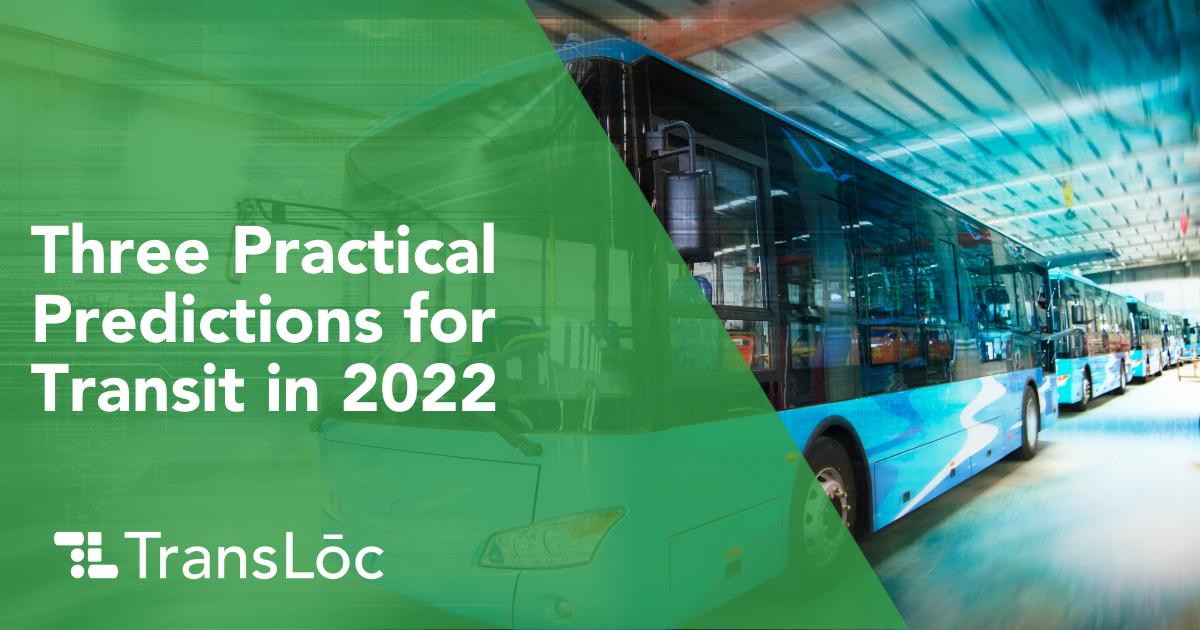
Did you blink and, all of a sudden, it was 2022? Yeah, us too.
Our eyes are wide open in the new year and we’re watching out for the moments that will change mobility forever. Between historic infrastructure investments, emerging green technology, and evolving ridership habits, we’ve got a lot to keep tabs on.
Some of our prolific thought leaders offered up their feasible predictions on the topics and technology that will cause transit providers to reimagine transit services in 2022 and beyond.
They’re a smart group, so we listened and wrote it all down.
Prediction: Driver Shortages Push Transit Agencies Towards Small Starts
Austin Stanion, Manager of Solutions Engineering: Transit agencies have dealt with driver shortages for decades, but we’ve seen this issue amplified as a result of the COVID-19 pandemic. During the Great Resignation of 2021, some agencies implemented on-demand microtransit services which do not require drivers to possess a commercial driver’s license to operate. This is an effective strategy, but it is not the be-all and end-all solution. A promise from the Biden administration and Secretary of Transportation Pete Buttigieg was to create more transportation-oriented jobs. Carrying out the items addressed in the Infrastructure Deal will require a sizable investment in labor. A big concern that seems to be missing is incentives that encourage individuals to fill those driver-shortage positions. With that said, transit agencies will take advantage of the Federal Transit Administration’s Small Starts program to help fund new or existing fixed transit systems such as light rail and commuter rail. Because of this, we could see a growth and push towards more light rail or streetcar launches, which may help address driver shortages given the high passenger capacity of rail services.
Consider This: The Infrastructure Deal is a game changer for U.S. transportation. Download our checklist for ways to use these funds, and watch transit experts from TransLoc, Ford Mobility & City Solutions*, the Association for Commuter Transportation, and the American Public Transportation Association discuss how this law will impact transit equity and accessibility.
Prediction: Bicycle and Pedestrian Safety Programs Accelerate Multimodal Projects
Ashley Schultz, Manager of Project Implementations: We will see a stronger focus on safety and Vision Zero programming in 2022. The Infrastructure Deal includes an unprecedented investment in action plans with an emphasis on bicycle and pedestrian safety through the $6 billion Safe Streets and Roads for All competitive grant program. How is this relevant to public transportation? It will support planning, design, and programming for first-mile/last-mile connections to transit and will likely lead to an increase in multimodal projects pursued by state and local governments. The pandemic will also continue to be a factor in mobility throughout 2022, and agencies will continue to prioritize health when making operational decisions such as how riders board or alight vehicles and pay fares.
Consider This: A comprehensive multimodal transportation system delivers unmatched mobility access to riders. At the University of California San Diego, we partnered with Spin under the Ford Mobility banner* to implement sustainable micromobility solutions and transit orchestration software for the community’s 75,000 students, faculty, and staff.
Prediction: Transit Fleets Turn A New Shade of Green
Tyler Means, Senior Business Strategist: Electrification of public transit fleets, and vehicles in general, will see skyrocketing popularity among transit providers and riders. Transit providers have long-standing goals of transitioning their fleet away from fossil fuels, whether it was to clean diesel, compressed natural gas, or propane (yes, propane). Federal funding assistance will certainly drive orders (and back orders) for electric vehicles. Similar to the electrification of mobility is the “greenification” of mobility. Lots of money is being set aside to build renewable energy sources and electric vehicle charging infrastructure to ensure greener energy from beginning to end. It’s important to mention that electrifying/greenifying vehicle fleets is one of many steps we need to take in reaching our environmental goals. Smart simulation software and data-driven planning and design will show transit providers how to efficiently deploy these vehicles to optimize performance and reduce roadway congestion.
Consider This: Using data to influence transportation planning will never go out of style. In fact, the smarter our transportation systems get, the more data they will produce that can be used to make proactive decisions about how to best serve riders. Planning & Design Services collaborates with transit providers by interpreting performance data and identifying opportunities to create sustainable transit systems, reduce operational costs, and improve equity and accessibility.
What do you think transit in your community will look like in 2022? Tell us on LinkedIn, Twitter or by chatting directly with one of our transit experts. Let’s share ideas and work together to make 2022 the year of reimagination for transit.
*On March 1, 2022, global technology company Modaxo acquired TransLoc from Ford Motor Company. TransLoc is no longer affiliated with Ford or any Ford properties.